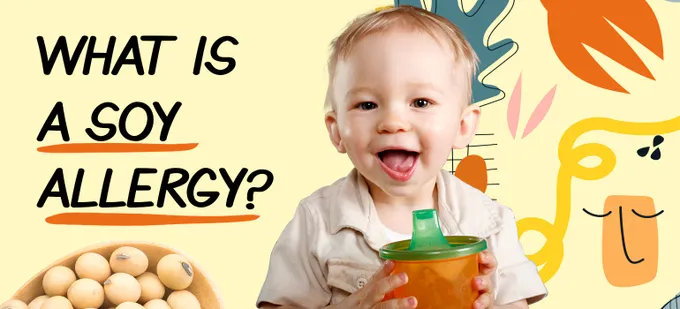What Are Soy Intolerance Symptoms in Kids?
Uncover signs of soy intolerance in kids and learn how to manage it effectively through dietary modifications.
Updated May 22, 2024

If your child has an allergy, you are not alone. According to the American College of Allergy, Asthma, and Immunology, allergies in infants and children are among the leading diagnoses of chronic diseases in childhood. Results from a 2018 study estimated that 5.6 million children in the U.S., or nearly 8%, have food allergies. That equates to 1 in 13 children or approximately 2 in every classroom.
» Managing a soy-free diet can be challenging. Explore our soy-free baby cereal and toddler formula to ensure your child gets the nutrition they need!
While any food can cause an allergic reaction, according to the American Academy of Pediatrics, 90% of food allergies in children are caused by just six common foods or food groups. These food or food groups include milk, eggs, peanuts, tree nuts, soy, and wheat. In fact, we cover all the soy allergy foods to avoid, in detail.
» Learn more about foods to avoid if your child has a soy allergy
What Is Soy?
Soy foods are made from soybeans, a member of the legume family that can be found in various forms in a variety of foods. Soy is a common ingredient in infant formulas and numerous other processed foods. In infants and children, soy is among the top six common food allergens.
» Read about reasons to avoid soy-based baby formula
The legume family includes many different types of beans, and also includes peanuts and lentils. You may be wondering if your child can eat other legumes if they are allergic to one legume. The good news is that 95% of people who are allergic to one legume can eat and tolerate other legumes, which decreases the need for further food restrictions.
» If your kid is on a soy-free diet, make sure it gets nutrient-dense foods for healthy weight gain
What Is a Soy Allergy?
Soy allergy is an allergy to the soybean plant, as well as foods like soybean oil and soy milk. It is common, particularly among infants and young children. If your child has a soy allergy, their immune system mistakenly treats soy proteins as harmful invaders. This prompts your child’s immune defenses, leading to various symptoms ranging from mild to severe. There are two main types of soy allergies.
» Boost your kid's immunity through nutrition to effectively manage soy allergy
IgE-Mediated Soy Allergy
When your child has an IgE-mediated soy allergy, their immune system makes unique antibodies called IgE antibodies to soy proteins to help fight them. These IgE antibodies generate symptoms of an allergic reaction whenever your child eats a food containing soy. Symptoms of an allergic reaction can occur within seconds to hours after they eat soy.
» Conquer the soy-free diet with nourishing baby and toddler plant-based formulas
Non-IgE-Mediated Soy Allergy
Non-IgE-mediated soy allergies also involve the immune system but don’t include IgE antibodies. Non-IgE-mediated soy allergies typically cause gastrointestinal symptoms hours to days after your child eats soy. There are different types of non-IgE-mediated soy allergies:
- Food protein-induced enterocolitis syndrome (FPIES) is a rare type of food allergy that typically affects babies. FPIES is commonly triggered by a reaction to milk, soy, oats, and rice. FPIES can cause vomiting around 2-4 hours after a child eats soy and can also cause diarrhea. Severe vomiting and diarrhea can lead to severe dehydration, which may require urgent medical attention.
- Food protein-induced allergic proctocolitis (FPIAP or allergic proctocolitis) causes inflammation in the lower part of the intestine when a child consumes soy. This allergy is typically caused by cow’s milk or soy and is generally seen in babies under one year of age. FPIAP usually causes abnormal stools that may be bloody, watery, or filled with mucus.
- Eosinophilic esophagitis (EoE) causes eosinophils, white blood cells linked with allergies, to build up in the esophagus. This causes a child’s esophagus to become inflamed, which creates pain when swallowing. Common food triggers of EoE may include milk, soy, egg, and wheat. Symptoms of EoE in babies and children can include vomiting, irritability, decreased appetite, chest pain, abdominal pain, reflux-like symptoms, and poor weight gain.
» Explore soy-free solutions to fuel your child's growth
Risk Factors for Developing a Soy Allergy
Children may be at increased risk of developing a soy allergy if there is a family history of other allergies, such as hay fever, asthma, hives, or eczema. Additionally, having existing food allergies to items such as wheat, beans or milk can also predispose a child to developing an allergic reaction to soy.
» Is your kid allergic to milk? Learn all about milk allergy signs and symptoms in babies
What Is the Difference Between a Soy Allergy and a Soy Intolerance?
The symptoms of soy allergy and intolerance can appear similar. However, the key distinction lies in the body's reaction.
A soy allergy triggers an immune system response, where the body produces antibodies called Immunoglobulin E (IgE) that release chemicals, causing an allergic reaction. This can lead to skin issues like hives and gastrointestinal and respiratory symptoms. In rare cases, it may even result in the life-threatening condition of anaphylaxis. In contrast, soy intolerance does not involve the immune system. It's the body's inability to properly digest the soy protein. Symptoms of soybean intolerance may include diarrhea, vomiting, stomach pain, and abnormal stools.
» Embrace a soy-free lifestyle for your family with nutritious, kid-approved formula
Symptoms of a soy allergy
Symptoms of an IgE-mediated soy allergy usually develop seconds to minutes after eating a soy product, and almost always within 2 hours. Soy allergy symptoms in kids or adults can range from mild to severe. IgE-mediated soy allergy symptoms may include:
- Vomiting, stomach cramps, diarrhea, indigestion
- Itchy, watery eyes, runny nose
- Difficulty swallowing
- Wheezing, shortness of breath, difficulty breathing
- Repetitive cough
- Tightness in throat, hoarse voice
- Weak pulse
- Pale or blue coloring of the skin
- Itching, hives (red raised bumps on the skin)
- Swelling of the face, including the tongue, lips, eyes, or throat
- Dizziness, fainting, confusion
Signs and symptoms of soy intolerance
Symptoms of a non-IgE-mediated soy allergy usually develop hours to days after eating a soy product. Symptoms of soy intolerance may include:
- Vomiting
- Diarrhea, stomach pain, abnormal stools
- Decreased appetite, poor weight gain
- Reflux-like symptoms
- Gas and bloating
- Irritability, lethargy
- Hives
If your child eats a food they are intolerant of, they may experience unpleasant symptoms. However, if your child has a true soy allergy, their body’s reaction to soy could be life-threatening, and it may be best to start early and look for a soy-free formula for your child.
» Learn more about the signs you should switch to soy-free baby formula
Do Children Usually Outgrow Soy Allergies?
Most children will eventually outgrow their soy allergy. One study found that about 25% of children outgrow their soy allergy by age 4, roughly 45% outgrow their soy allergy by age 6, and nearly 70% outgrow it by age 10.
A 2020 study reported that the highest prevalence of soy allergy (1.5%) was found at age 1 year. However, after age 1, prevalence rates steadily decreased to a low of 0.2% at ages 14 to 17. This recent research is encouraging news for families concerned about whether their children will outgrow their soy allergy or not.
» Is it time to transition to soy-free formula? Know the signs
The chance of outgrowing a soy allergy may depend on whether it is IgE-mediated or non-IgE-mediated. Non-IgE-mediated soy allergies are usually outgrown in early childhood, while IgE-mediated soy allergies can be outgrown but, in some cases, may persist throughout one’s life.
What Foods Should a Child with a Soy Allergy Avoid?
Children with soy allergies must strictly avoid all soy and products containing soy. Even the slightest intake of soy could potentially cause an allergic reaction. To keep your child safe, it’s imperative that you always carefully read food labels. Soy is one of the eight major allergens that must be listed on packaged foods sold inthe U.S., as required by federal law. Despite this requirement, avoiding soy can still be tricky—here's what you should be aware of.
» Here's what you need to know about choosing dairy and soy-free formula
Soy and soy products to strictly avoid
- All types of soy milk, soy cheese, soy yogurt, and soy ice cream
- Soybean oils, including cold-pressed, extruded, and expelled soybean oil
- Many children with soy allergies can safely eat highly refined soybean oil. It is best to speak with your allergist to make sure highly refined soybean oil is okay for your child to consume.
- Soy sauce
- Soy nuts and soy “nut butter”
- Soy protein, including concentrated soy protein, hydrolyzed soy protein, isolate soy protein
- Soy albumin
- Soy flour
- Soy fiber
- Soy grits
- Soybean curd
- Soybean granules
- Soy lecithin
- Some children with soy allergies can safely eat soy lecithin, but it is important to consult your allergist to make sure soy lecithin is safe for your child to eat.
- Any other ingredient containing the word “soy” or “soybean”
Foods that may contain hidden soy
- Bread rolls and other baked goods
- Candies
- Cereals
- Chocolate bars
- Crackers
- Chicken nuggets
- Processed meats
- Plant-based “alternative meats” (vegetarian or vegan substitutes for meat products, like burgers and chicken, as many are soy-based)
- Baby formulas
- Broths
- Margarine
- Canned meat and fish
- Low-fat peanut butter
- Granola bars/ nutrition bars
- Sauces
- Products with “natural flavors” (the “natural” flavoring may include soy)
Foods containing soy under a different name
- Edamame (another name for soybeans)
- Miso (fermented soybean paste used as seasoning)
- Soya, or any product with soya in its name (another way to write “soy”)
- Shoyu (Japanese-style soy sauce)
- Tamari (another type of Japanese soy sauce)
- Teriyaki (sauce)
- Worcestershire sauce
- Kinako (soy flour)
- Nimame (simmered soybeans)
- Okara (soy pulp)
- Tempeh (cake-like fermented soybeans)
- Tofu (blocks of condensed soy milk/soybean curd)
- Textured vegetable protein (soy-based alternative to ground meat)
» Find out what to look for in soy-free baby formula
Risk of Cross-Contamination
When shopping or ordering food in restaurants, be aware of cross-contamination. In stores, look out for products that say "may contain soy" or "manufactured on equipment that also processes soy." This is a sign that there was likely cross-contamination in the plant where the product was made. Consequently, there could accidentally be traces of soy in these products.
» Choosing the right soy-free baby formula eliminates the risk of cross-contamination
Testing for Soy Allergies
An allergist will likely ask questions about what and how much your child ate, how long it took for symptoms to develop, which symptoms they experienced, and how long they lasted. Oftentimes, an allergist will pair the answers to these questions with different tests to confirm whether your child has a soy allergy.
» Prioritize high-fiber, soy-free foods for a balanced, nutritious kids' diet
Soy allergy tests
Skin prick test
A skin prick test involves placing a drop of the suspected allergen on the skin. A needle is used to prick the top layer of skin so a small amount of the allergen can enter the skin. If your child is allergic to soy, a red bump will appear at the spot of the prick.
Intradermal skin test
In an intradermal skin test, a larger amount of the suspected allergen is injected underneath your child’s skin with a syringe. This test may be more sensitive than a skin prick test. Again, if your child is allergic to soy, a red bump will appear at the spot of the injection.
Radioallergosorbent test (RAST)
The RAST is a blood test that can measure the amount of the IgE antibody in the blood. This test is sometimes performed on babies under a year old because their skin doesn’t react as well to prick tests.
» Nourish your little one with delicious, whole, plant-based nutrition
How to Test for Soy Allergies at Home
An allergist may recommend using an elimination diet with your child at home. The elimination diet seeks to eliminate or isolate suspected foods that can cause a reaction. The following are the steps involved in following an elimination diet:
» Discover the benefits of offering whole foods to babies and toddlers
Elimination diet steps
Step 1. Start a Food Journal
Spend at least one week writing down everything your child eats throughout the day. Note any symptoms your child may experience, the time they happen, and for how long.
Step 2. Note Possible Suspects
Review the food journal keeping in mind that reactions to food can happen anywhere from minutes to days after your child eats a particular food. Write down possible suspects or foods that appear to trigger a reaction.
Step 3. Begin the Food Elimination Process
Remove the foods you’ve identified as possible suspects and make an effort to help your child avoid these foods. Try to eliminate these foods for at least 2 weeks.
Step 4. Implement the Food Challenge
Once your child is symptom-free, you can begin to implement the food challenge. The food challenge involves reintroducing the suspected foods one at a time and carefully watching for symptoms. If the food challenge results in symptoms, do not continue the challenge until your child is symptom-free for at least 24 hours.
It is important to understand that an elimination diet should only be initiated under the supervision of an experienced healthcare professional. This is to avoid further complications and possible undernourishment.
» Introduce a delicious, soy and dairy-free alternative to your child's diet
Prevention of Soy Allergies
If your baby has an allergy to any food, then consult your healthcare provider before introducing soy. Discuss with your provider about the quantity of soy that would be safe to introduce.
While it’s not possible to prevent a food allergy, the American Academy of Allergy Asthma and Immunology recommends the following measures to help reduce the risk of soy allergy.
1. When possible, exclusively breastfeed your baby for the first four to six months or use a hypoallergenic formula. Breast milk will help strengthen your baby’s immune system and may reduce the risk of allergies.
» Here's all you need to know about hypoallergenic formula
2. Introduce solid foods at around the age of 6 months. Begin by introducing your child to mild foods like apples, pears, bananas, sweet potatoes, squash, carrots, rice, or oats. Try to introduce one food item at a time and continue it for three to five days. This will help you to identify any intolerances or allergies.
» Check out our comprehensive guide on introducing solid foods
3. After you know your baby can tolerate mild foods, introduce common allergic foods like soy, eggs, milk, peanuts, and fish. New research has shown that delaying the introduction of allergenic foods for a baby’s first 1-3 years of life can actually increase their food allergy risk. Instead, try introducing your baby to common allergenic foods early and often, between 4-11 months of age.
» Find out how to safely introduce allergens to your baby
Healthy Alternatives to Soy: Try Something Else!
If your child has a soy allergy or intolerance, removing soy from their diet can be complicated. They may also have an intolerance to both soy and milk protein, called Milk Soy Protein Intolerance (MSPI). MSPI is an intolerance that babies eventually outgrow, affecting 2-7% of babies under 1 in the U.S. Over half of those babies with a milk intolerance may also develop a soy protein intolerance.
» Here's how to find out if your toddler is lactose intolerant
Allergy-friendly Else Plant-Based Complete Nutrition is the ideal soy and dairy-free, plant-based alternative for 1-year-old toddlers and older. It provides the ideal amounts of protein, fat, fiber, vitamins, and minerals to ensure your child’s optimal growth and development.
» Discover nutritious soy and dairy-free, plant-based formula for toddlers
The content and advice provided in this article are for informational purposes only and are not a substitute for medical diagnosis, treatment, or advice for specific medical conditions. Always consult a pediatrician to understand the individual needs of your child.
















